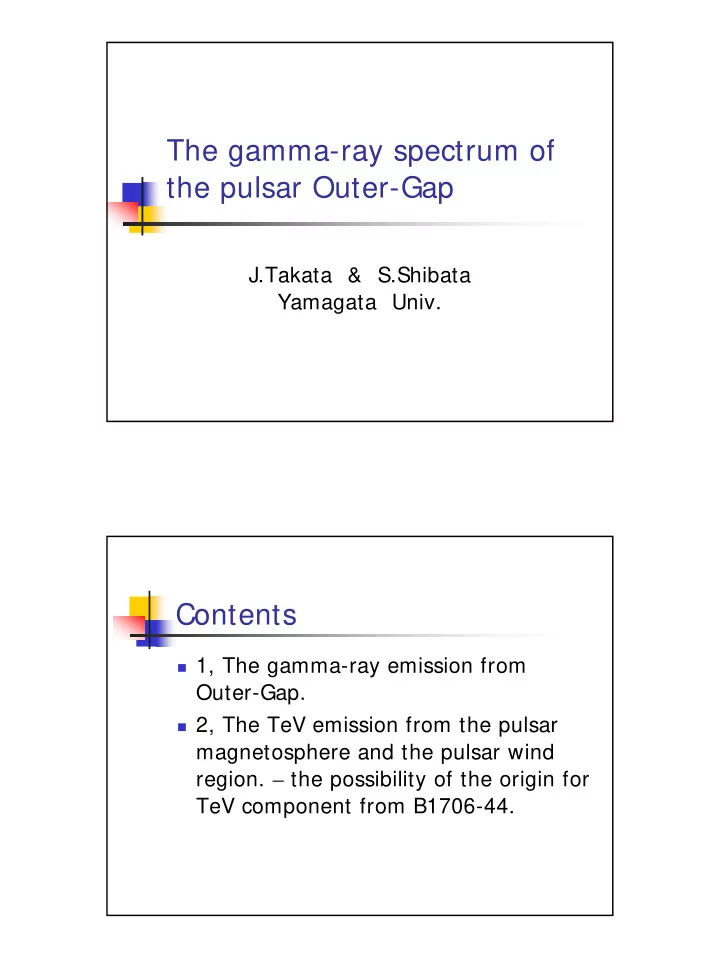

The gamma-ray spectrum of the pulsar Outer-Gap J.Takata & S.Shibata Yamagata Univ. Contents � 1, The gamma-ray emission from Outer-Gap. � 2, The TeV emission from the pulsar magnetosphere and the pulsar wind region. – the possibility of the origin for TeV component from B1706-44.
1, Introduction: gamma- ray pulsars (7 pulsars) radio optical X-ray Gamma-ray • Where and How are the particles accelerated and gamma-rays radiated in the pulsar magnetosphere? 1, Introduction: The acceleration of particles in the magnetosphere The pulsar is the electric dynamo with about Outer Gap * The electric field along the magnetic field accelerates the particles. * This grow up in the region (gap) , where the charge disagree with the Goldreich-Julian density. * The gamma-rays are radiated by the curvature, inverse-Compton processes Polar Cap
1, Introduction: Outer-Gap model (previous works) * Romani (1996) -three dimensional model(pulse shape,phase resolve spectra) -assuming electric field * Hirotani & Shibata (1999, HS model) - solved the electric field with curvature radiation and pair-creation process self-consistently - one dimensional model along the magnetic field line - the spectrum is consistent with observation in GeV bands I improve the spectrum of HS model by taking account of the radiation from outside of the gap 2, Outer-gap model: The electrodynamics in the gap * the accelerated electrons (positrons) control the accelerating field * the distribution of particles is determined by the pair-creation rate of the gamma-rays with X- rays * the distribution of the gamma-rays is determined by the emissivity of radiation and the
2, Outer-Gap model: The radiation from outside of the gap The original HS model thought the gap emission, only But.., * The gap width is characterized by the pair-creation mean free path. * Particles escape from the gap with Gap width * Particles can radiate the curvature photons at the outside of the gap as well as in the gap. 2, Outer-Gap model: The gamma-ray spectrum of the one-dimensional model(Vela) Model parameter ν F ν spectrum The assumed the current in the gap, inclination angle and the cross section area * Gap emission is consistent with observation in GeV bands, but is inconsistent in MeV bands * The total spectra is consistent with observation above 100MeV * The ~ 1MeV emissions are synchrotron radiation, probably
2, Outer-Gap model: Vela .vs. B1706-44 * Vela and B1706-44 are similar pulsars * The spectral peek energies are ~ 1GeV (B1706-44) and ~ 3GeV (Vela) -this difference is produced in the result of our model, naturally * The difference of rotational speed produce the difference of -the distance to the gap (and the light cylinder) from the surface -the strength of magnetic field in the gap Our model can explain the observed spectral features 3, TeV emission from around pulsar: The TeV gamma-rays from B1706-44 * The CANGAROO group observed the TeV gamma-ray in the direction of B1706-44 -can not explain the ordinary synchrotron -inverse Compton process of the synchrotron nebula (Kushida et. al. 2002) * I calculated the TeV emission from the Outer-Gap. -it is also difficult to the explain by the gap emission -small the soft-photon density around the gap (following discussion) It may be the another origin.
3, TeV emission from around pulsar: Pulsar Wind The possibility of the another radiation region * The wind particles are accelerated at somewhere IC OG * The wind particle carry out the almost the spin down IC luminosity of the pulsar * This region may bright at TeV bands by IC process assumption Wind particles are accelera- ted to the Lorentz factor of 3 ・ 10 6 at light cylinder. ? 3, TeV emission from around pulsar: The luminosity of IC process * The inverse Compton luminosity ability probability * The TeV luminosity at the each regions -Gap region -Wind region
3, TeV emission from around pulsar: PSR B1706-44 * The CANGAROO observation (Kushida,2002) * The needed soft-photon density to obtain the observed luminosity is at d= 2.5 kpc (in the gap) ( in the wind region) We compare this needed density with the predicted density 3, TeV emission from around pulsar: The predicted photon-field around B1706-44 * The soft- photon energy : Infrared The predicted spectral * The Rayleigh-Jeans region of surface black body: kT= 143eV * The non-thermal radiation -no available observations for Infrared -the observations for pulsed X-ray and optical (upper limited point) can be interpreted as
3, TeV emission from the needed soft photon density around pulsar: Result * The gap region -the scattering photon energy~ 0.01eV too small small * The wind region -the scattering photon energy~ 0.1eV too small OK This TeV component may have the origin of the pulsar wind Summary (1) By taking account of the radiation from outside � of the gap to the HS model, the spectrum is consistent with observation above 100MeV The our Outer-Gap model explain the observed � spectral peak energies and features of Vela and B1706-44, naturally. To compare the more detail observations, for example the phase resolved spectra, we are now extending the one-dimensional model to the two- dimensional.
Summary (2) � It is difficult to explain the TeV gamma-rays from the B1706-44 by the out-gap emission. � If the pulsar wind particles are accelerated at near the light cylinder, this TeV component may be the detection of the emission from the pulsar wind. � If this component is the detection of the wind component, it is the first directly observation for the pulsar wind.
Recommend
More recommend